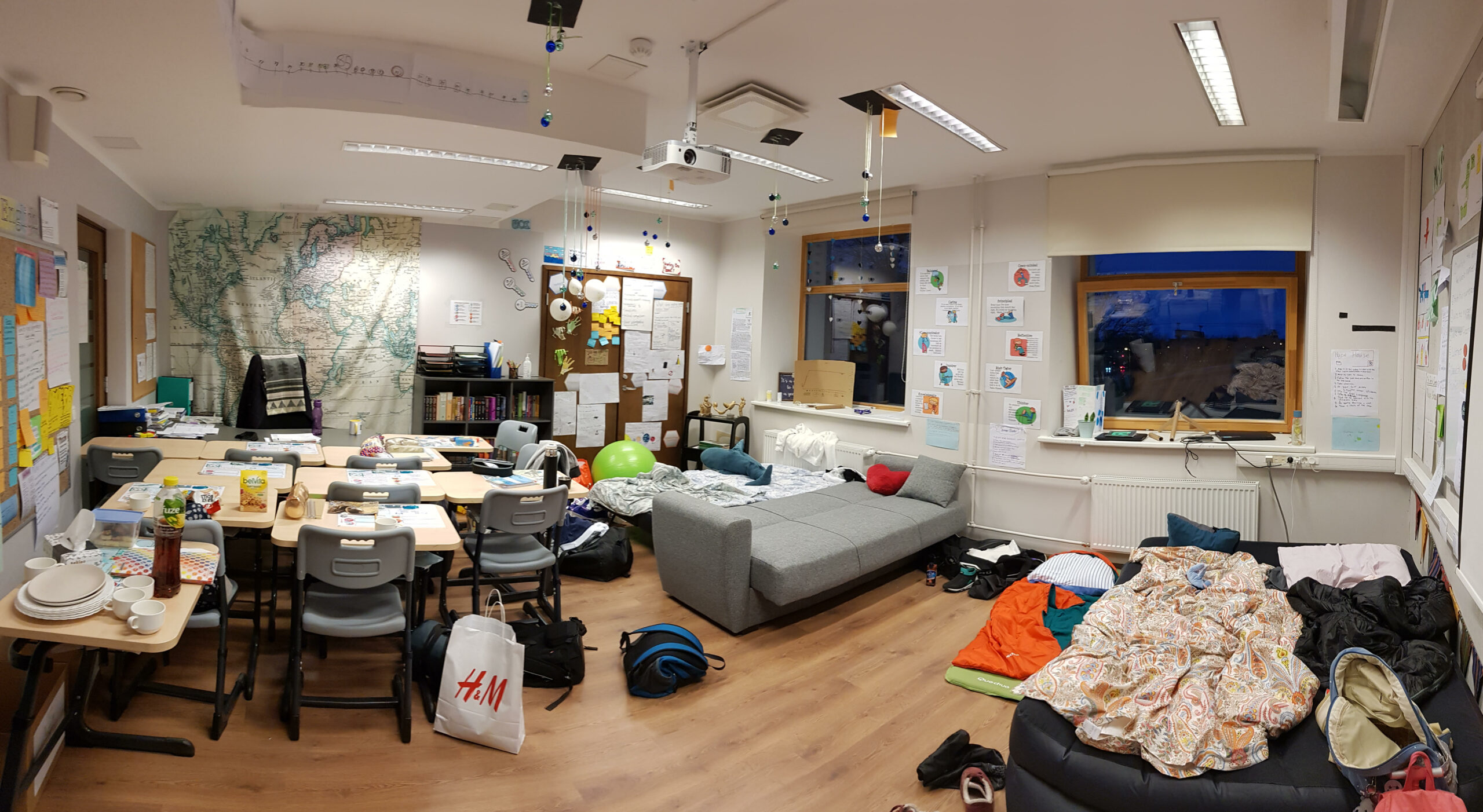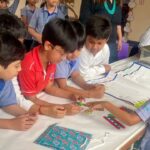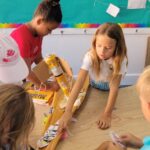This article is based on an example of how students re-imagined a mundane classroom as a hotbed of space exploration, and how giving students agency to creatively re-imagine learning spaces can inspire taking action.

By Lynne Bibi
“The PYP: From principles into practice supports flexible learning spaces where ‘students who are involved into designing their learning spaces feel greater ownership and influence over their learning.'”
Remember when you were a child and the living room suddenly became an obstacle course? That same living room became a hotbed for spies and agents with secret bases behind the couch and a jail under the table. It goes without saying that the floor was, occasionally, lava.
I have learned that encouraging students to see their learning space as an opportunity, or blank canvas, can truly inspire creativity and meaningful connections. As educators, we almost always try to have hands-on provocations when tuning in to a central idea. How many teachers have redesigned learning spaces according to a certain theme or worked hard to set up engaging learning environments? We set these up for the students and throw them inside to get them thinking of big ideas and inquiring questions. Yet how many students have agency not only to interact with their learning spaces, but to re-imagine them completely? I realized that continuing this practice of re-imagining and designing learning spaces with increasing student agency would motivate my students to tangible action at the end of our unit. The PYP: From principles into practice supports flexible learning spaces where “students who are involved into designing their learning spaces feel greater ownership and influence over their learning”.
In a unit inquiring into how space exploration and technology have impacted life, we began exploring constellations as one of the earliest forms of space exploration—observation. With given guidelines, students created their own constellations and hung them from the ceiling, noting how they only form a recognizable “picture” when viewed from a certain angle. They concluded that constellations are basically human constructs, with a practical purpose only on Earth. We took our passion for the stars further and made constellation tubes that we debuted in our walk-in storage closet at the back of the class.
 Walking into that storage closet was an inspirational experience for the students. They all noticed it was dark and much colder than our classroom. Eyes lit up and creative thinking skills began whirring, and they realized that we had gone on a field trip to space. Two units later, that closet is still called “space” by all the students in the classroom. At this moment, learning spaces were being re-imagined and there was no holding back as the reins shifted from teacher to students. A week later, as I rotated guided reading groups, students who were not reading with me were given agency to change our learning space to reflect our learning. We already had “stars” hanging from the ceiling, and our own makeshift planetarium, what was next?
Walking into that storage closet was an inspirational experience for the students. They all noticed it was dark and much colder than our classroom. Eyes lit up and creative thinking skills began whirring, and they realized that we had gone on a field trip to space. Two units later, that closet is still called “space” by all the students in the classroom. At this moment, learning spaces were being re-imagined and there was no holding back as the reins shifted from teacher to students. A week later, as I rotated guided reading groups, students who were not reading with me were given agency to change our learning space to reflect our learning. We already had “stars” hanging from the ceiling, and our own makeshift planetarium, what was next?
Students tipped unused chairs and created a “rocket launching corner” where they could sit back and imagine lifting off as the SpaceX astronauts were doing that very day! This became a favourite spot during class transitions. Students mimicked the words they heard on live broadcasts of launches and the ISS. For a class where English is not a first language for the vast majority, these imaginative games and spaces helped foster language practice and transcended language barriers. As the PYP: the learning community outlines, learning spaces should be accessible and accommodate welcoming flexible zones for different activities, such as dramatic play.
“Watching my classroom be transformed into a constellation exhibition, planetarium, rocket launchpad, and sleepover room was incredible. “
 Then came the most ambitious action of all. Students began to ask me that if we were learning all about space, how come we were not studying at night? Students lobbied the school administration with an action plan to conduct a night class at school on star-gazing and light pollution. Their logic and enthusiasm were undeniable. Our classroom transformed once again into a sleepover room where students spent a night in school to learn about light pollution in an authentic setting. This learning was finally cultivated into a science fair where students employed their communication skills to share their experience and knowledge with other PYP students of various grades.
Then came the most ambitious action of all. Students began to ask me that if we were learning all about space, how come we were not studying at night? Students lobbied the school administration with an action plan to conduct a night class at school on star-gazing and light pollution. Their logic and enthusiasm were undeniable. Our classroom transformed once again into a sleepover room where students spent a night in school to learn about light pollution in an authentic setting. This learning was finally cultivated into a science fair where students employed their communication skills to share their experience and knowledge with other PYP students of various grades.
 Watching my classroom be transformed into a constellation exhibition, planetarium, rocket launchpad, and sleepover room was incredible. I definitely didn’t imagine all this as I sat down with my unit planner 5 weeks before. The students swept me up into a fantastical realm where you really can go to space from the classroom. I learned that re-imagining learning spaces and encouraging student creativity in seeing a chair as a rocket allows for enthusiastic and hands-on learning experiences on topics that are hard to manifest.
Watching my classroom be transformed into a constellation exhibition, planetarium, rocket launchpad, and sleepover room was incredible. I definitely didn’t imagine all this as I sat down with my unit planner 5 weeks before. The students swept me up into a fantastical realm where you really can go to space from the classroom. I learned that re-imagining learning spaces and encouraging student creativity in seeing a chair as a rocket allows for enthusiastic and hands-on learning experiences on topics that are hard to manifest.

Lynne Bibi is a 5th grade Homeroom teacher at the International School of Tallinn. Lynne is passionate about sustainability and learning spaces. She has presented in a conference about bringing street art into literacy classes and made her own classroom swing and other flexible seating options out of upcycled materials and without a budget. Lynne is a PYP enthusiast and has been teaching in PYP classrooms since 2016. She is every administration’s dream as her constantly changing learning spaces require a very low budget, but occasionally ends up sleeping in school with her students which results in a little more paperwork.




Amazing work and I learned a new concept of constantly changing learning spaces. I’m interested to know other themes you have implemented in your classroom.